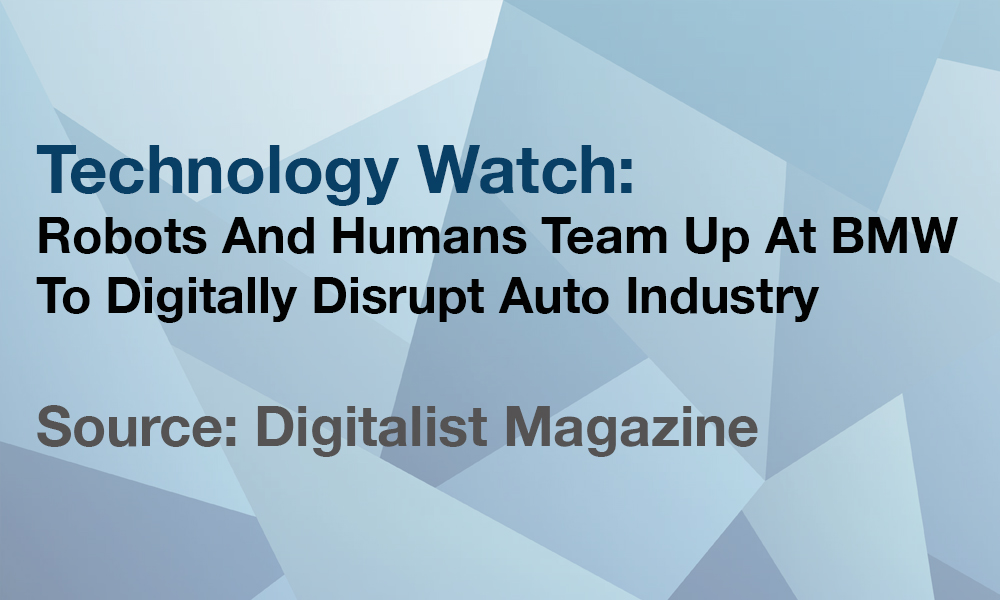Source: Digitalist Magazine
A few years ago, BMW created a new team at an assembly plant in Spartanburg, South Carolina.
Installing sound insulation and water-sealing vehicle doors is not a one-person job. On the new team, one team member spreads out material and glues it to the door. A second team member holds the material in place.
What made this team so unique?
One team member is human. The other is a robot.
Human-robot partnerships are just one way the auto industry uses digital technologies today. Pioneering companies are disrupting the sector by rethinking business models, business processes, and work.
Significant savings, safety improvements
Previously, installing sound insulation and water sealing was done very differently. A worker would apply a foil with an adhesive bead. A manual roller was then used to fix the foil to the vehicle door.
The process requires precision for good reasons. Electronics embedded in the car door must be protected. Likewise, the car’s interior parts can be damaged by moisture.
When the process was done exclusively by humans, the workers were rotated off the line every hour or two to prevent elbow strain.
Today, four robots work collaboratively with workers. Roller heads installed on robot arms handle the task now. The labor-intensive and ergonomically challenging issues are gone.
The robots operate at a low speed and stop automatically if sensors detect an object in the way. Quality is also maintained as the applied rolling power can be set and measured.
Collaborative bots are growing segment
Collaborative robots, or co-bots, are increasingly being used in the automotive industry and elsewhere.
A Massachusetts Institute of Technology researcher studying human-robot collaboration at a BMW plant found startling results. Teams of human and robot collaborators outperformed both all-human and all-robot teams. The collaborative team also reduced human idle time by 85%.
Collaborative robots represent only about five percent of the robotics market. The collaborative robot sector could grow tenfold by 2020. Estimates place the market at more than $1 billion annually by then, compared to $95 million in 2014.
More advancements coming
BMW officials predicted rapid deployment of collaborative robots at other sites.
In 2015, BMW began using co-bots elsewhere. Now the co-bots insert hard rubber plugs into holes in a vehicle chassis. Employees were suffering from numerous thumb injuries, but the new co-bots have mechanical “super-thumbs.”
The next generation of these robots demands new features.
The differences between collaborative robots and traditional industrial robotics are significant. For one, safety needs to be a priority consideration. For another, interactivity skills are still at a basic stage in some robotic applications.
A 2013 issue of The Economist discussed the issue at length. “(R)obots have so few skills that even a seemingly simple task such as handing over an object commonly ends in a tug-of-war,” wrote the magazine.
American automotive giant General Motors is investing in solving the hand-off issue. GM-funded research is designing robots that can sense if a person wants an item. These next-gen robots will know if a human worker uses a power tool or documentation.
Digital changes business models, processes, and work
The digital revolution has come to the auto industry. It’s driven by smart connected products, supercomputing, Big Data, cloud computing, and shifting consumer expectations.
These changes affect the entire automotive value chain, including design, production, distribution, and retail.
Examples are everywhere. Sensors and computers connect to vehicles, transmitting data on performance. On-demand, just-in-time, and mobility services are plentiful. Digital marketing, online sales, and in-car telematics are changing consumer interactions.
Automobile companies have an opportunity to seize on this shifting digital industry.
New business models
Business models need to consider data, connectivity, and customer centricity. New models can focus on mobility with integrated services. Detailed analytics are offered for energy-efficient connected vehicles. Other new business models factor a digitally connected supplier network.
Companies can monetize new services that consumers seek in their relationships with brands. Vehicle information, entertainment, and e-commerce are new revenue sources.
New business processes
Forward-thinking companies can gain market share by improving business processes too. These new processes permeate the value chain from R&D to service. Below are some examples.
- Smart connected plants become more automated, producing vehicles without major disruptions to manufacturing flow. Networked logistics hubs track traffic and manage the network services.
- Supply-side coordination helps manage component supply to match demand permanently. Inbound logistics allow for accurate scheduling of goods pickups and deliveries.
- Location-based services let companies offer consumers value-added services in the moment of need. Service management lets companies move into businesses other than sales.
New ways of working
Finally, digital innovation changes the way employees work.
Data analytics programs deliver information anywhere in real time to staff. Decision-making and productivity both can improve.
Digital business processes cut some manual transactions and work.
Predictive software requires new skills in workers to ensure accurate machine and robotic work. Interactive features change the relationship with consumers, offering information and services.
Conclusion
The BMW example shows the power of embracing digital technology. For auto companies, the future brings new innovation and opportunity.
Rethinking business models lets companies find new markets. New processes lead to better efficiency and partnerships. The work itself changes as employees use better data to connect to consumers.
To learn more about digital transformation for the automotive industry, view Automotive. Reimagined for the new economy.
Author: Holger Masser

